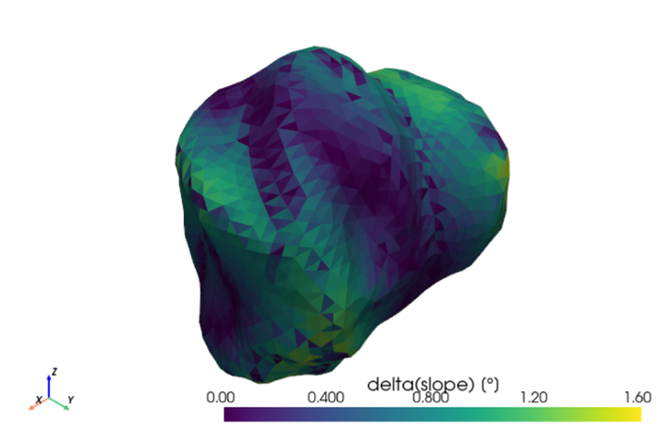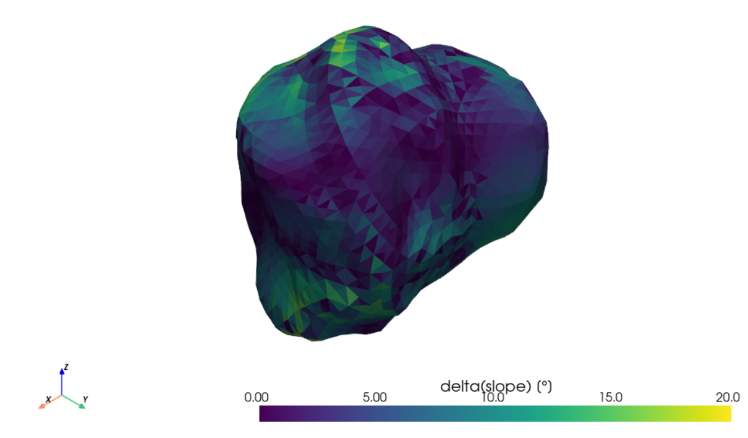- Royal observatory of Belgium, Brussels, Belgium (elisa.tasev@observatory.be)
In April 2029, asteroid Apophis (2004 MN4) will flyby Earth and pass less than 32000 km from its surface. During this close encounter (CE), the asteroid will experience dynamical changes due to its gravitational interaction with the Earth ([1],[2],[3]). Several missions are currently being studied to observe and characterize Apophis before and during the CE ([4],[5]), and additionally the OSIRIS-APEX spacecraft will make a post-Earth-encounter rendezvous with the asteroid [6]. Apophis will also be observed by ground-based telescopes during its passage [7].
Apophis is a tumbling body or a non-principal axis (NPA) rotator. The gravitational forces of the Earth will likely change Apophis’ rotational speed significantly ([1],[2],[3],[8]). They may also alter its regolith configuration resulting in resurfacing due to local avalanches [9]. The variations of dynamical and orbital parameters, such as the spin, obliquity and longitudinal and latitudinal librations will provide unique insights about the behavior of such asteroids during their close flyby of planets. Resurfacing mechanics has important implications for interpreting surface observations, including space weathering effects on these bodies.
For both the dynamical and the gravitational simulations, we use a radar-based shape model for Apophis [10] while the Earth is modeled by an ellipsoid of revolution. The surface accelerations for Apophis are computed using the polyhedron model with a constant density [11]. The gravitational interactions between the Earth and Apophis during CE are determined using the open-source GUBAS propagator implementing the full-two-body problem (F2BP) [12]. The simulations are propagated from when Apophis enters Earth’s sphere of influence. Preliminary analysis showed that depending on the initial ecliptic longitude, the rotational speed of Apophis can either increase of decrease. The CE also has a major influence on Apophis obliquity depending on initial conditions (Figure 1) [8].
Figure 1 Obliquity change with different initial conditions.
To assess the possible surface changes of Apophis during the CE, we investigate the variations of surface acceleration and dynamic slopes. We combine the self-gravity of Apophis with the contributions of the dynamics of the system (tidal forces and Euler acceleration). The dynamic slopes are defined as the angle between the surface normal and the surface acceleration vector. Initial results suggested changes of about 3% on surface gravity and less than a few degrees on slopes for the selected initial conditions [13]. Introducing a tumbling state of Apophis constrained by [14] shows slightly larger results [8].
Here we investigate the locations susceptible to resurfacing of Apophis during the CE under different initial orientation conditions, as the instantaneous orientation of the asteroid is not well determined unlike its orbital state. Compared to previous work [1], we consider a full tumbling state of Apophis constrained by observations [14] following the method shown by [7]. The influence of the initial orientation on the surface accelerations shows significant changes depending on the studied cases (Figure 2, Figure 3). These changes in Apophis rotation and local gravity, including potential localized resurfacing across its surface, are important parameters for planetary defense missions since they provide information on otherwise inaccessible interior and mechanical properties of the asteroids.

Figure 2 Slope changes for tumbling case at CE

Figure 3 Slopes changes for extreme obliquity change case at CE
[1] Souchay, J., Lhotka, C., Heron, G., Herv´e, Y., Puente, V., & Folgueira Lopez, M. (2018). “Changes of spin axis and rate of the asteroid (99942) Apophis during the 2029 close encounter with Earth: A constrained model”, Astronomy and Astrophysics, 617, 1–11.
[2] Souchay, J., Souami, D., Lhotka, C., Puente, V., & Folgueira, M. (2014). “Rotational changes of the asteroid 99942 Apophis during the 2029 close encounter with Earth”, Astronomy and Astrophysics, 563, 1–6.
[3] Benson C.J. et al. “Spin state evolution of (99942) Apophis during its 2029 Earth encounter” (2023) Icarus, Vol. 390, 115324
[4] Küppers M. et al. “STATUS OF ESA’S RAPID APOPHIS MISSION FOR SPACE SAFETY (RAMSES) CONCEPT” (2024), Apophis T-5 Years Workshop
[5] Karatekin Ö. et al. “SATIS MISSION STUDY FOR APOPHIS: Science objectives and mission definition.” (2024), Apophis T-5 Years Workshop
[6] Nolan M. C. et al. “THE OSIRIS–APEX MISSION TO APOPHIS” (2024), Apophis T-5 Years Workshop
[7] de León J. et al. “OPPORTUNITIES TO STUDY APOPHIS USING THE CANARIAN OBSERVATORIES BEFORE, DURING, AND AFTER ITS CLOSE APPROACH IN APRIL, 2029” 2024), Apophis T-5 Years Workshop
[8] Sert H. et al. “Changes in Rotational Dynamics and Surface Accelerations Induced by the Earth Encounter of Apophis » (2024), Apophis T-5 Years Workshop
[9] Yu Y. et al. “Numerical predictions of surface effects during the 2029 close approach of Asteroid 99942 Apophis” (2014), Icarus, Vol. 242, 82-96.
[10] Brozović et al. “Goldstone and Arecibo radar observations of (99942) Apophis in 2012–2013” (2018), Icarus, Vol. 300, 115–128.
[11] Werner R.A. and Scheeres D.J. "Exterior gravitation of a polyhedron derived and compared with harmonic and mascon gravitation representations of asteroid 4769 Castalia." (1996), Celestial Mechanics and Dynamical Astronomy 65.3, 313-344.
[12] Davis, A. B., Scheeres, D. J. “Doubly Synchronous Binary Asteroid Mass Parameter Observability” (2020a), Icarus, Vol. 341, 113439
[13] Noiset et al. “Changes in Apophis rotation and surface gravity during its 2029 Earth flyby” (2023), 8th IAA Planetary Defence Conference
[14] Pravec et al. “The tumbling spin state of (99942) Apophis” (2014), Icarus,
How to cite: Tasev, E., Sert, H., and Karatekin, Ö.: Changes in Apophis surface accelerations due to changes in its dynamical state during the 2029 Earth flyby, Europlanet Science Congress 2024, Berlin, Germany, 8–13 Sep 2024, EPSC2024-889, https://doi.org/10.5194/epsc2024-889, 2024.